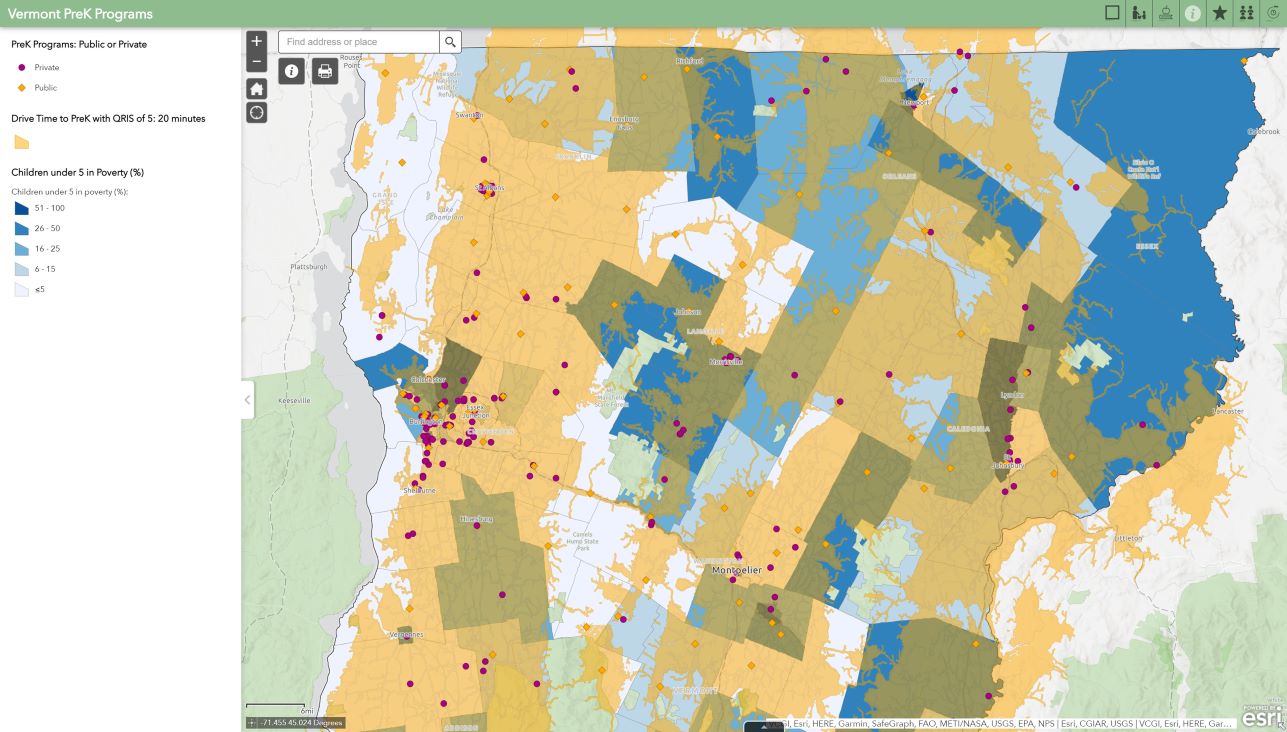At a time when the funding of prekindergarten (preK) programs across the country is declining, Vermont lawmakers and state agencies are looking to understand how to improve universal preK programming in the state. Vermont is one of nine states in the United States that provides families with universal preK funded through their K–12 education funding formula. Universal preK in Vermont was signed into law in 2014 and provides 10-hours a week of free, publicly funded preK for all 3-year-olds, 4-year-olds, and preK-eligible 5-year-olds through a mixed-delivery system of public and private programs.
Universal preK in Vermont is co-overseen by the Agency of Education (AOE) and Child Development Division (CDD) of the Agency of Human Services. With funding for universal preK assured, Vermont lawmakers and state agencies are looking at data to ensure that high-quality local preK programs are available for all Vermont families.
Fortunately, there is a lot of existing data regarding the current availability of preK in Vermont. According to a 2020 Regional Educational Laboratory (REL) Northeast and Islands report that examined the enrollment rates of children in universal preK in Vermont in 2016/17, children were equally enrolled in public (49 percent) and private (51 percent) programs. Of those children enrolled, most children (83 percent) were enrolled in a program within the bounds of their local education agency. However, preK children who lived in an area without a publicly funded preK program were more likely to be enrolled in lower quality programs and programs outside of their local education agency of residence. Furthermore, when availability of preK programs was limited, data suggested that families were “enrolling their children in preK programs that were farther from their home.”
The REL Northeast and Islands’ study highlighted a critical area for further exploration—how are publicly funded preK programs distributed across the state and are there places where availability may be limited? To address these questions, the Vermont AOE teamed up with the Region 1 Comprehensive Center (R1CC) to develop a geographic information system (GIS) map that can help Vermont legislators, state agencies, advocates, and caregivers better understand the current landscape of publicly funded preK programming in the state.
The goal of this project was to develop a map that presents information about preK availability across Vermont—a visual way to dig into some of the questions that can inform strategies to improve availability. The map provides key information related to preK availability and need in Vermont. This includes:
- Type of preK program (public school versus private).
- The quality rating of the program.
- Program location.
- Drive time to preK programs in 10-, 20- and 30- minute radii.
- Population characteristics (for example, percentage of children under 5 in poverty).
- Local education agency boundaries.
To demonstrate the use of the map, let’s address the question: “Are there areas of the state that are not within a 20-minute drive of preK programs prequalified for universal preK funding?” The map below overlaps data to show (a) the location of prequalified public or private programs eligible to provide universal preK (indicated by purple and orange dots, respectively), (b) the 20-minute drive time radius from any preK program (indicated by the yellow shaded regions), and (c) regions of the state where children under 5 live in poverty (the darker the blue, the higher the percentage).

As highlighted in the map, in the northeastern part of the state there are large areas of land shaded in dark blue (indicating a higher percentage of children under 5 in poverty) that are not within a 20-minute drive to a public or private preK program (the shaded yellow areas).
There are some important caveats to consider in looking at these data, such as the mountainous geography of the area and the rural nature of the region, but even with those considerations taken into account, this map highlights a potential gap in preK program availability in this area of the state.
So how might this information be used? Using the map, AOE and CDD may identify areas of the state that could merit further investigation into the availability and accessibility of preK options. If additional analysis indicates that there are early childhood education programs in the area, but they are not approved and eligible for universal preK funds, the state could incentivize those programs to become approved. If data should indicate there are no programs available in that section of the state, CDD could consider incentivizing the opening of new private programs or AOE could incentivize more local public schools to provide preK programming. This map is a useful tool for starting a conversation rooted in action—now that the state has identified a potential gap, what steps can it take to address it?
In the coming months, the Vermont AOE and R1CC staff will continue to collaborate to incorporate additional data into the map. In the future, GIS mapping of these data could shed light on the impact of COVID-19 on the availability of publicly funded preK programs or help AOE understand the state’s cradle-to-career initiatives. This map will also be shared with the Vermont legislature as they revisit potential changes to preK legislation.
Further, AOE and R1CC plan to extend the map beyond preK availability by integrating data on local and regional access to wraparound support services to better understand what services and supports are available preK to grade 12 and where gaps may exist. As more data from across the state are incorporated into the map, more detailed questions about preK access and availability can be answered. The R1CC sees GIS mapping as a key strategy that will continue to inform the state’s efforts to increase access to high-quality preK programs for all.
The contents of this blog were developed under a grant from the Department of Education. However, those contents do not necessarily represent the policy of the Department of Education, and you should not assume endorsement by the Federal Government.